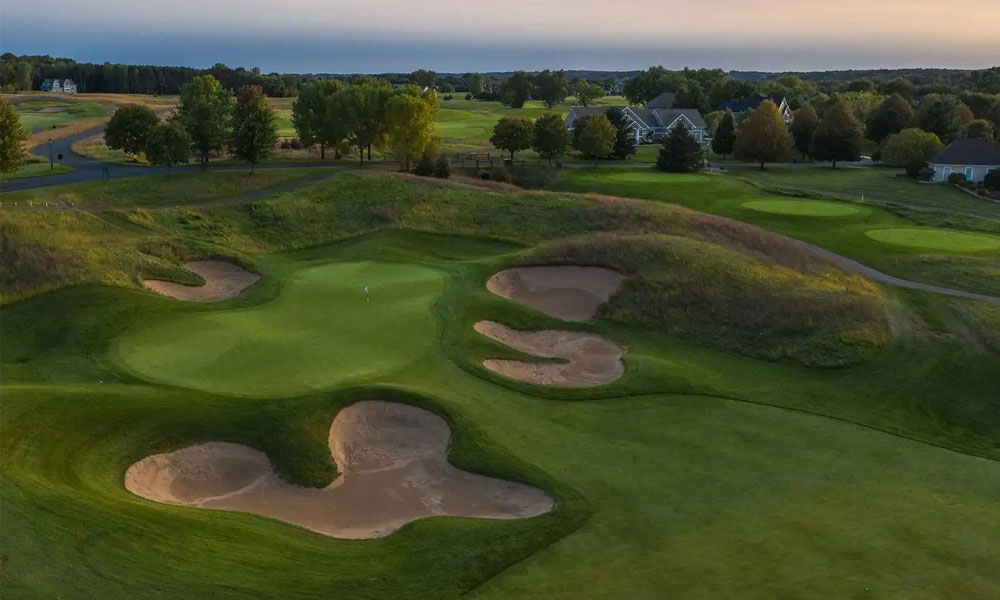Discover Troy Burne Golf Club: Tom Lehman-Designed Championship Course


Troy Burne
Troy Burne sprawls over 420 acres of undulating terrain in the St. Croix Valley, just east of the Twin Cities. The 1996 Open champion Tom Lehman teamed up with Michael Hurdzan and Dana Fry to craft this well-bunkered design, featuring expansive fairways and sloped greens. Numerous ponds and creeks influence play on many holes, particularly around the greens, highlighting the importance of approach shots. With minimal tree coverage, wind frequently becomes a significant factor.
Set on the eastern bank of the St. Croix River, the course is the focal point of a residential development, with most fairways circling the property’s periphery, while homes remain hidden behind protective trees at the center of the estate.
Bunkers are a prominent feature throughout, with approximately 120 hazards constructed from native sand influencing play. The back nine hosts nearly all the water hazards, where the holes meander through a tree-lined hollow near the river.
Troy Burne is regarded as one of the top daily access facilities in the region. Just east of the Minnesota-Wisconsin border, this Tom Lehman-designed prairie course boasts several strong golf holes. Notably, the stretch from the 10th to the 14th hole builds excitement, especially the par-three 11th, a stunning short hole flanked by tall, shaved pine trees. Behind these trees lies a downhill par-three and par-five, with a pond challenging any shot veering left on either hole. Troy Burne offers a beautiful walk and a demanding course, with the back nine being particularly noteworthy. While the front nine may not be as inspiring, it is still well above average, with standout par-fours like the second and fourth holes requiring precise play. Ultimately, Troy Burne stands as one of the best courses in the area, whether it measures up to StoneRidge’s dramatic layout or Keller’s storied history is less important.
Troy Burne Golf Club boasts over 120 bunkers safeguarding spacious bent grass fairways and stadium greens. Located a short 30-minute drive from St. Paul in Hudson, Wisconsin, it offers an unforgettable golf experience. The club’s expanded clubhouse is ideal for weddings and events, providing panoramic views of the course. Despite being the finest public course in the Twin Cities Metro area, this gem in the St. Croix River Valley often flies under the radar for many Wisconsin golfers.
Lacking the historic significance of other courses, Troy Burne compensates with exceptional conditions, a renowned local head pro, and tour-quality conditions. The course has had national acclaim by hosting the Nationwide’s Scholarship America Showdown in 2004 and 2005, attracting golfers like Jason Dufner, Brent Snedeker, Bill Haas, and Kevin Stadler.
When it opened in 1999, Golf Digest named it the best new public golf course in America. It has since been listed in their Top 100 Public Golf Courses from 2017 to 2020. Ranked fifteenth in the state, it surpasses notable courses such as Green Bay CC, The Club at Lac La Belle, and Westmoor. Designed by Michael Hurdzan and Dana Fry with Tom Lehman’s consultation, Troy Burne aligns itself with legendary courses like Erin Hills, Philadelphia Cricket Club’s Militia Hill, and Wisconsin Dells’ Wild Rock.
This 6,978-yard, par 71 course features five challenging par-threes and over 120 bunkers, primarily greenside. The Championship tees at 6,424 yards still present a formidable challenge, with three of the four par-fives playing over 500 yards. The tricky green at the 118-yard fifteenth is a standout feature.
Troy Burne has consistently held high accolades, recently being sold to Bill Holst, Forbes’ “most successful caviar entrepreneur,” who owns five other golf courses in Minnesota. The club has seen numerous upgrades, including a new wedding venue, three simulators, enhanced sand traps, and improved Yamaha electric carts with GPS.
Having played the course countless times over the past two decades, it remains endlessly thrilling. The putting green, situated behind the first tee box, taunts golfers as they anticipate their opening drive.
Key points to remember while playing include: avoiding the over 120 traps, noting pin locations to play to the proper quadrant, and enjoying the experience of playing the best course in the Twin Cities.
Hole 1 (Par 5, 600 yards, 5 hcp):
Troy Burne starts with a demanding par-five emphasizing course management. The fairway is generous yet riddled with potential hazards. Straying left puts you among large oaks, necessitating a tough layup. Rightward shots face a steep hill and deep rough. The elevated green is best approached from the left, negotiating around six bunkers guarding it. With fourteen traps in total, making par here feels like an early victory.
Hole 2 (Par 4, 444 yards, 3 hcp):
The second hole presents a perplexing challenge. The fairway is generous for those willing to lay back and take a longer second shot. However, a lake on the left and two bunkers on the right complicate matters. The green is guarded by three more bunkers and water short left. Walking away with a six here isn’t uncommon.
Hole 3 (Par 3, 173 yards, 17 hcp):
This par-three completes one of the most challenging opening stretches. Two deep bunkers front left and right guard the green, demanding a precise shot. The green has a subtle spine, making accurate placement critical.
Hole 4 (Par 4, 342 yards, 15 hcp):
Hole four is the course’s only drivable par-four. Despite being surrounded by twelve bunkers, long hitters are tempted to attempt the green with their driver, especially downwind.
Hole 5 (Par 5, 582 yards, 1 hcp):
This lengthy par-five typically requires three shots, with favorable conditions and two excellent shots providing the only hope of reaching in two. Five fairway bunkers await stray tee shots, with another four guarding the green.
Hole 6 (Par 4, 364 yards, 11 hcp):
The sixth hole directs golfers over or around six towering traps. The wild green, sloping severely back to front, poses a significant challenge. Misplaced balls can lead to four-putts from inside fifteen feet.
Hole 7 (Par 4, 391 yards, 13 hcp):
An elevated tee offers a spectacular view of this par-four. Playing downwind allows long hitters to aim over three bunkers to find a favorable landing area. Eleven traps, including a small pot bunker near the green, challenge golfers throughout the hole.
Hole 8 (Par 3, 222 yards, 9 hcp):
This long par-three deceptively appears uphill due to the fairway drop-off. The large, deep bunker on the green’s left side frequently attracts tee shots.
Hole 9 (Par 4, 488 yards, 7hcp):
A challenging closure to the front nine, this par-four typically plays downwind. Ten traps must be avoided to reach the flatter green, providing a great scoring opportunity.
Hole 10 (Par 4, 413 yards, 10 hcp):
The back nine begins with a strong dogleg left par-four, flanked by a lake and a waste bunker. The approach, often over a bunker and avoiding water, is demanding.
Hole 11 (Par 3, 176 yards, 14 hcp):
The signature par-three eleventh offers a stunning backdrop. A front pin offers a potential ace, while a back-right pin dares a bold approach. Shots landing left often funnel towards the back-right corner.
Hole 12 (Par 5, 491 yards, 6 hcp):
This par-five, reminiscent of a par-four, hugs the shoreline and descends to a peninsula green. The green itself provides significant defense due to varying pin positions.
Hole 13 (Par 3, 195 yards, 16 hcp):
This elevated tee par-three plays downhill, utilizing a subtle backboard for tucked pins.
Hole 14 (Par 4, 458 yards, 4 hcp):
One of the most demanding holes, the fourteenth runs alongside the lake. A precise fade is ideal off the tee. The approach, uphill with a creek and traps, includes a picturesque waterfall.
Hole 15 (Par 3, 140 yards, 18 hcp):
Despite its length, this par-three features the most challenging green. A deceptive spine and numerous breaks test golfers’ putting skills.
Hole 16 (Par 5, 608 yards, 2 hcp):
The longest hole is a true three-shot par-five. The tee shot must avoid water and out-of-bounds. Precise positioning on the second shot is crucial to navigate the six traps.
Hole 17 (Par 4, 434 yards, 12 hcp):
This downhill par-four’s pond demands accuracy off the tee. Fairway bunkers frame the hole, and the approach to a generous green protected by the pond is a test.
Hole 18 (Par 4, 467 yards, 8 hcp):
A strong finishing par-four with no gimmicks, demanding focus to avoid traps and fescue. A challenging second shot to an elevated green concludes the round on a high note.
Recent Posts
South Carolina State Leaders Honor Green’s Superintendent Career
South Carolina’s House of Representatives today honored the career of golf course superintendent Chuck Green.…
Branson, Missouri: 5 Reasons Why it is a Must-Visit Travel and Golf Destination
Branson, Missouri, is booming as a must-visit destination for golf enthusiasts and travelers alike. Nestled…
Preview more than 1,000 rounds of golf available in GCSAA’s Rounds 4 Research online auction
The Golf Course Superintendents Association of America (GCSAA) Rounds 4 Research program offers golfers the…
EcoBunker Synthetic Revetting More Sustainable than Natural Turf*
*A recent report by the Welsh government has found that EcoBunker synthetically revetted bunkers have…
SiteOne® Hires Dan Carrothers as VP, Agronomic Business Development
SiteOne® Landscape Supply is pleased to announce Dan Carrothers as the new Vice President for…
Superintendents Online Turf Directory – EVERYTHING TURF
Our online directory, directory.GolfCourseTrades.com is the go-to resource for the busy superintendent. It is your opportunity…


